Princes' Islands
- Details
- Created on 17 February 2013
- Last Updated on 01 April 2013
Princes' Islands
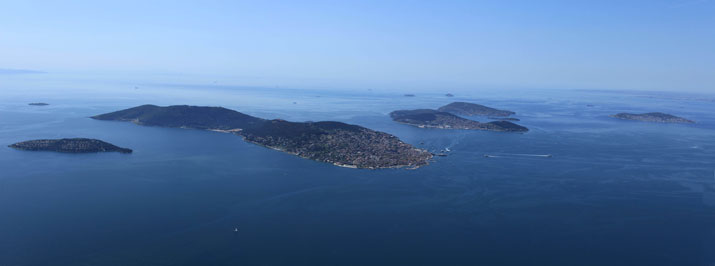
The Princes’ Isles, known in Turkish as Adalar, or the Islands, are a little archipelago off the Asian coast of the Sea of Marmara southeast of the southern end of the Bosphorus. The isles have always been a maritime suburb of Istanbul, the great metropolis on the Bosphorus, Greek Constantinople, ancient Byzantium. The group consists of nine islands, all but four of them tiny and sparsely inhabited. The nearest is some fifteen kilometers from the ferry terminal in Istanbul at the confluence of the Golden Horn and the Bosphorus, the farthest about twenty-six kilometers, though in spirit they seem at a far greater remove than that, since they are so different in appearance and atmosphere from the imperial city on their western horizon.
Nine İslands

Ferries stop in turn at the four principal isles, the closest of which is Kınalıada ( known to the Greeks as Proti), followed by Burgazada (Antigoni), Heybeliada (Halki), and finally Büyükada (Prinkipo), the largest and most populous of the isles. During the summer months ferries also stop at Sedefadası (Antirovithos). There are a few summer residents on Kaşıkadası (Pita), but Tavşanadası (Neandros), Yassıada (Plati) and Sivriada (Oxia) are uninhabited, except for a single hermit now living on the latter isle.
Büyükada (Prinkipo)
Büyükada, the Greek Prinkipo, is the largest and most beautiful of the Princes’ Isles. This is the only one of the islands that most people visit and it is the summer resort par excellence.
With an area of 5.4 square kilometers, Büyükada is larger than the other three major islands combined. It is also the most populous of the islands, with about 6,500 residents year-round and some 40,000 in the summer.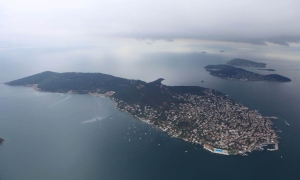
The island is about 4.3 kilometers long from north to south and averages about 1.3 kilometers in width from east to west. It has two lofty hills: Isa (Hristos or Christ) Tepesi, to the north, rising to a height of 164 meters, and to the south Yüce Tepe (Great Hill), known to the Greeks as Hagios Georgios (St. George), with an elevation of 202 meters, the highest peak in the Princes’ Isles. The two hills are separated in the middle of the island by a broad valley, known to the Greeks as Diaskelo. The northernmost part of the island is now completely built up, but farther south are lovely pine groves and other forests, wild cliffs plunging into the sea, and isolated sandy coves.
Heybeliada (Halki)
 Heybeliada is the second largest of the islands, with an area of 2.35 square kilometers. It has a year-round population of about 5,500, which in summer increases to some 30,000. Halki, the Greek name of the island, which means "copper," comes from the copper mines that were worked here in antiquity, mentioned by Aristotle. The island took its Turkish name, Heybeli, from the word for saddlebag, heybe, which it is said to resemble because of the shape of its hills and their intervening valleys.
Heybeliada is the second largest of the islands, with an area of 2.35 square kilometers. It has a year-round population of about 5,500, which in summer increases to some 30,000. Halki, the Greek name of the island, which means "copper," comes from the copper mines that were worked here in antiquity, mentioned by Aristotle. The island took its Turkish name, Heybeli, from the word for saddlebag, heybe, which it is said to resemble because of the shape of its hills and their intervening valleys.
The hills are Ümit Tepesi, formerly known as Papaz Dağı (85 m.), in the north of the island, Değırmen Tepesi (136 m.) and Köy Tepesi (128 m.) in the center, and Baltacıoğlu Tepesi (98 m.) in the southwest. The core of the village is on the northeast shore, from where its houses spread in tiers along the slopes of Ümit Tepesi, Değirmen Tepesi, and Köy Tepesi and the valleys between them.
Burgazada (Antigoni)
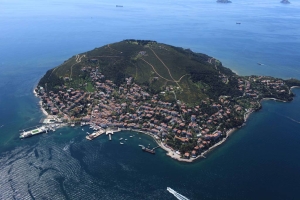 Burgazada is the third largest island in the archipelago, with an area of 1.5 square kilometers. It has a year-round population estimated at 1,500, which in summer increases to about 15,000.
Burgazada is the third largest island in the archipelago, with an area of 1.5 square kilometers. It has a year-round population estimated at 1,500, which in summer increases to about 15,000.
In antiquity the island was known as Panormos, but in Byzantine times it was called Antigoni, the name still used by the Greeks. The Turkish name of Burgaz is a corruption of the Greek pyrgos, or tower, from an ancient watchtower on its summit that is mentioned by Evliya Çelebi and other travelers up until the early nineteenth century. The watchtower can be seen on the summit of the island in an engraving done in 1794 by Cosimo Comidas. The engraving shows the island bare except for what appear to be an orchard and two or three cultivated patches on the side of the hill.
The single hill, Hristos Tepesi (Christ Hill), also known as Bayraktepe (Flag Hill), rises to a height of 170 meters in the middle of the island. The center of the village is on the northeast coast of the island, its houses stretching from there along the heights above the northern shore. The shore roads extend around all of the island except its inhospitable south coast, where precipitous cliffs hang over the sea.
Kınalıada (Proti)
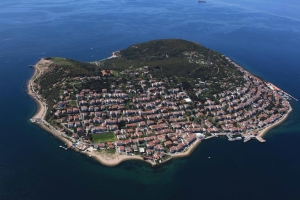 It is the smallest of the four major islands, with an area of 1.356 square kilometers. The island takes its Turkish name, which means "henna-red," from the color of the sandstone cliffs that plunge into the sea at its eastern end. The Greeks have always called the island Proti, or First, since it is the nearest of the islands to the city.
It is the smallest of the four major islands, with an area of 1.356 square kilometers. The island takes its Turkish name, which means "henna-red," from the color of the sandstone cliffs that plunge into the sea at its eastern end. The Greeks have always called the island Proti, or First, since it is the nearest of the islands to the city.
Kınalıada has three peaks, with Çınar Tepesi (Plane Tree Hill) rising in the northeast of the island to an elevation of 115 meters, Teşrifiye Tepesi (110 m.) in the center, and Manastır Tepesi (93 m.) in the south.
The island has a winter population of some 1,000, while in summer the number increases to about 15,000. The village spreads around the north and east sides of the island, sloping down in tiers along the slopes of the three hills. The focal point of the village, here as in the other three major isles, is the vapur iskelesi, or ferry landing, on the northeast shore. The new iskele for the sea bus is just beside the pier for the regular ferry on its south side.
Sedefadası (Antirovithos)
 Sedefadası, the Greek Antirovithos, is about 1,200 meters east of the central part of Büyükada. Sedef is the fifth largest of the isles, measuring 680 by 250 meters, its highest point fifty-five meters above sea level. The name of the island is said to derive either from sedef (mother-of-pearl) or from sedefotu, the rue plant commonly found here.
Sedefadası, the Greek Antirovithos, is about 1,200 meters east of the central part of Büyükada. Sedef is the fifth largest of the isles, measuring 680 by 250 meters, its highest point fifty-five meters above sea level. The name of the island is said to derive either from sedef (mother-of-pearl) or from sedefotu, the rue plant commonly found here.
Sedefadası is served by ferry from mid-June to mid-September. Those who are not residents or their guests are not allowed to enter the gated community, but are restricted to a restaurant above the iskele and a pebble beach along the shore to the right of the landing stage. The most beautiful part of the island is its eastern shore, which is luxuriantly wooded with cypresses and umbrella pines as well as a rich variety of other trees.
Sivriada (Oxia) and Yassıada (Plati)
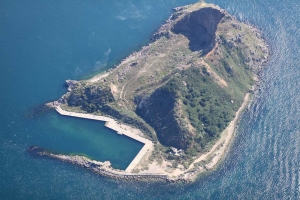 Sivriada and Yassıada are off to the west of the other islands of the archipelago, sixteen to seventeen kilometers south of the entrance to the Bosphorus and fifteen kilometers off the Asian coast. They can be reached by hiring a motor boat at any of the major islands.
Sivriada and Yassıada are off to the west of the other islands of the archipelago, sixteen to seventeen kilometers south of the entrance to the Bosphorus and fifteen kilometers off the Asian coast. They can be reached by hiring a motor boat at any of the major islands.
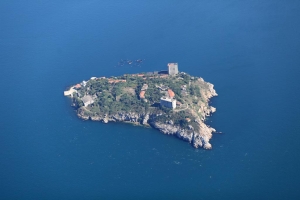 The Greek name of Sivriada is Oxia and that of Yassıada is Plati. Sivriada, which is about two kilometers to the northwest of Yassıada, is somewhat the smaller of the two, but it is more noticable because its peak is more than twice as high as that of the other isle. The Turkish and Greek names are descriptive and mean the same thing in each case: Sivri-Oxia meaning "Pointed" and Yassı-Plati meaning "Flat." Yassiada was also known as Hayırsızada (Useless Island), a name still used by some local residents.
The Greek name of Sivriada is Oxia and that of Yassıada is Plati. Sivriada, which is about two kilometers to the northwest of Yassıada, is somewhat the smaller of the two, but it is more noticable because its peak is more than twice as high as that of the other isle. The Turkish and Greek names are descriptive and mean the same thing in each case: Sivri-Oxia meaning "Pointed" and Yassı-Plati meaning "Flat." Yassiada was also known as Hayırsızada (Useless Island), a name still used by some local residents.
Tavşanadası (Neandros)
 Tavşanadası, or Rabbit Island, known to the Greeks as Neandros, is some two kilometers off the southernmost point of Büyükada, from which it can be reached by hiring a motor boat at the iskele. It is the second smallest of the isles, after Kaşıkadası, with an area of 10,000 square meters, its highest point forty meters above sea level.
Tavşanadası, or Rabbit Island, known to the Greeks as Neandros, is some two kilometers off the southernmost point of Büyükada, from which it can be reached by hiring a motor boat at the iskele. It is the second smallest of the isles, after Kaşıkadası, with an area of 10,000 square meters, its highest point forty meters above sea level.
It is once known to both Turks and Greeks as Neandros, the most remote of the Princes’ Isles from Istanbul. The most beautiful part of the island is its southern shore, which is formed by a rock cliff that plunges sheer into the sea, with myriads of cormorants and seagulls perched like sentinels on its crags.
Vordonos Adası (Vordonosi)
About midway between Kınalıada and the Asian coast there is a tiny islet called Vordonosadası, which is sometimes included as a part of the archipelago. Tiny though it is, it too was the site of a Byzantine monastery, founded in the second half of the ninth century by the patriarch Photius. The ruins of the monastery can still be seen on the island, whose only other monument is a lighthouse.


 History
History 